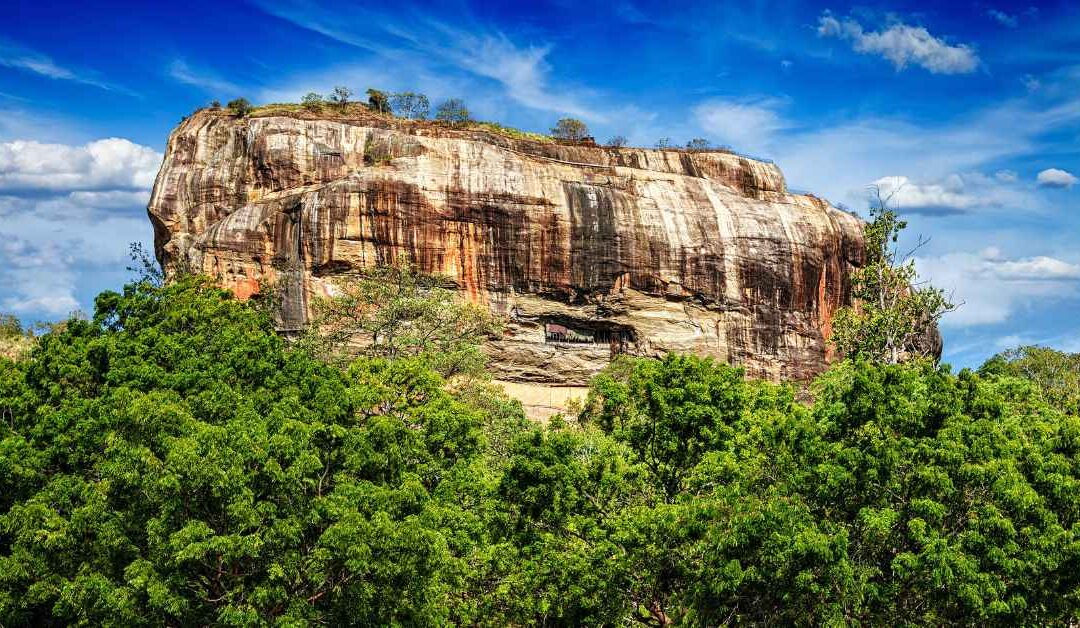Introduction
Sigiriya, famously known as the Lion’s Rock, stands as an architectural marvel and a testament to Sri Lanka’s rich history. Rising abruptly from the central plains of the island nation, this UNESCO World Heritage Site boasts a storied past dating back over 1,500 years.
Sigiriya’s Significance
This ancient rock fortress holds more than just historical significance—it’s a repository of legends and mysteries that captivate both historians and travelers. Believed to have been formed from the magma of an extinct volcano, Sigiriya holds a mythical aura that has inspired tales of gods and ancient kings.
King Kasyapa’s Legacy
The tale of King Kasyapa, who ascended the throne through a controversial move, unfolds at the heart of Sigiriya’s narrative. In a bid for power and security, Kasyapa constructed his royal residence atop this monumental rock. The fortress-palace he built was a marvel of ancient engineering, a fusion of artistic vision and strategic defense.
Architectural Wonder
Sigiriya’s architectural grandeur lies not only in its strategic location but also in its intricate design. Elaborate water gardens, terraced landscapes, and sophisticated irrigation systems adorned the base of the rock. Ascending the steep ascent meant passing through ingeniously designed pathways, staircases, and finally, the iconic Lion Gate, guarded by colossal lion paws that once formed a majestic lion’s head.
Cultural Tapestry
Beyond its structural magnificence, Sigiriya is a canvas of cultural heritage. The rock’s walls are adorned with ancient frescoes depicting celestial maidens, their vibrant colors speaking of a bygone era’s artistic finesse. The Mirror Wall, known for its polished surface that once reflected the images of passersby, now holds inscriptions and poems, providing a glimpse into the thoughts and sentiments of ancient visitors.
Sigiriya, steeped in history and mystery, continues to draw travelers, historians, and art enthusiasts alike, inviting them to unravel its enigmatic tales and witness the legacy of a civilization etched into the very stone of the Lion’s Rock.
Historical Background
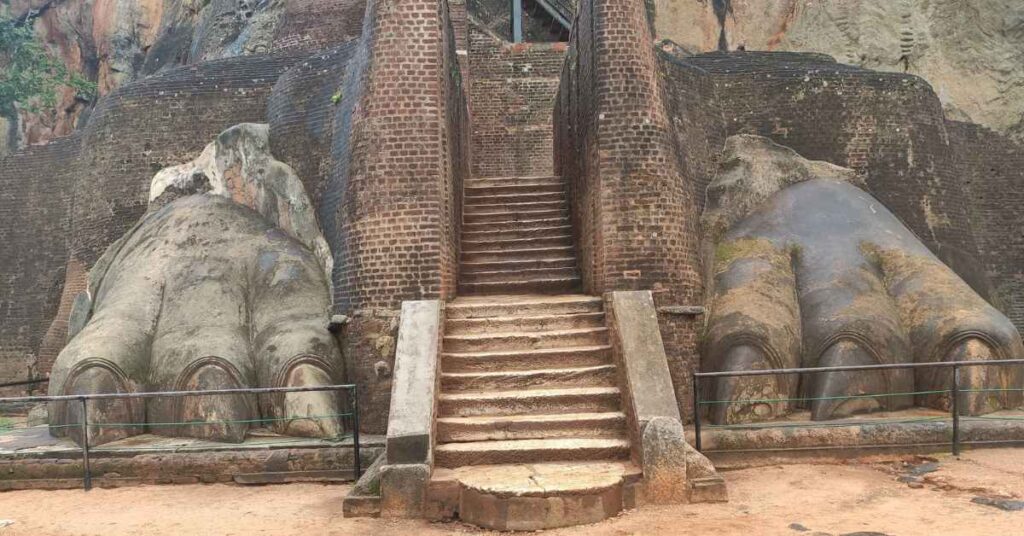
Sigiriya, or the Lion’s Rock, emerges from the heart of Sri Lanka’s historical tapestry, entwined with the reign of King Kasyapa and a rich cultural legacy that echoes through centuries.
Origins and Cultural Significance
Dating back to the 5th century, Sigiriya carries the weight of ancient tales and folklore. Its very creation is steeped in myth, believed by some to be the remnant of a celestial palace, while others attribute its formation to a volcanic eruption that left behind this colossal rock edifice.
King Kasyapa’s Ambition
The narrative of Sigiriya finds its central character in King Kasyapa, an enigmatic ruler driven by ambition and a desire for security. Kasyapa, estranged from the royal capital of Anuradhapura due to a controversial ascent to the throne, sought a sanctuary where he could assert his power and protect himself from potential adversaries.
Construction of the Fortress-Palace
To realize his vision, Kasyapa orchestrated an engineering marvel—the construction of a fortress-palace atop Sigiriya. The rock’s summit was transformed into a regal abode adorned with exquisite architecture, elaborate gardens, and advanced hydraulic systems that showcased the kingdom’s engineering prowess.
Choice of Location and Architectural Marvels
The selection of Sigiriya as the site for this ambitious project wasn’t arbitrary. Its natural defenses—sheer cliffs and a commanding view of the surrounding plains—rendered it an ideal location for a fortress. The elaborate gardens at the base of the rock, featuring symmetrical layouts and intricate water systems, added to its allure and functionality.
Cultural Heritage and Legacy
Beyond its role as a fortress, Sigiriya emerged as a cultural hub. Its frescoes, portraying celestial maidens known as the “Sigiriya Damsels,” provide a glimpse into the artistic achievements and societal norms of ancient Sri Lanka. The Mirror Wall, once polished to a reflective sheen, now bears inscriptions that speak of admiration for the site’s beauty and the musings of its visitors.
Sigiriya’s historical background reveals a convergence of power, ambition, and artistic expression, offering a window into the rich heritage of Sri Lanka’s ancient civilizations. The story of its creation and the legacy it leaves behind continue to intrigue and captivate visitors from around the world.
Architectural Marvels of Sigiriya
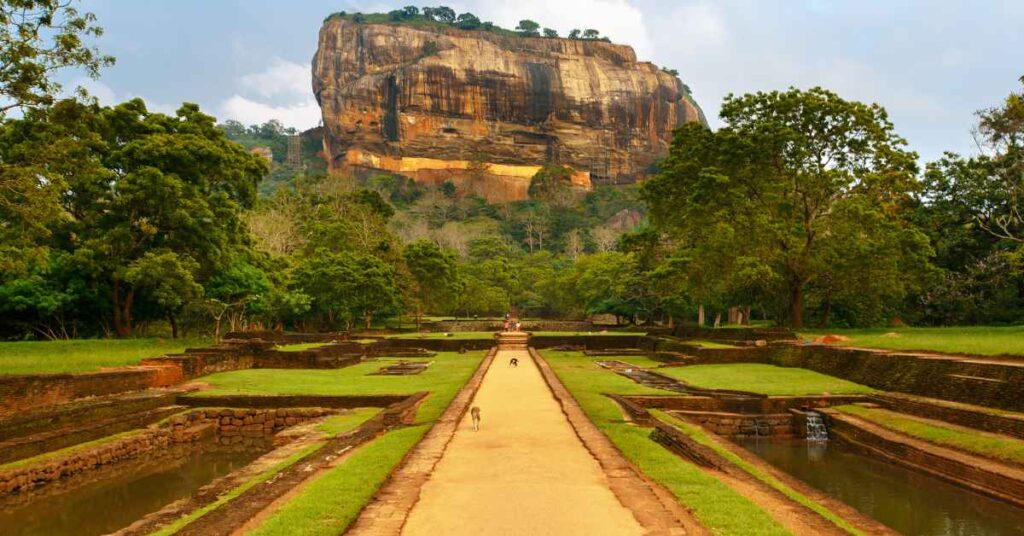
Sigiriya stands as a testament to the ingenuity and architectural prowess of ancient Sri Lankan civilization. Its captivating design and structural marvels have continued to awe visitors for centuries, showcasing a harmonious blend of artistry and strategic planning.
Terraced Gardens and Hydraulic Systems
At the base of Sigiriya, visitors are greeted by an elaborate network of terraced gardens, an exemplar of ancient landscaping. These meticulously designed gardens, adorned with fountains, ponds, and symmetrically laid-out pathways, speak volumes about the sophisticated irrigation and hydraulic systems of that era. The engineering precision behind these gardens highlights the mastery of water conservation and distribution in an age long before modern technology.
The Frescoes of Sigiriya
One of the most captivating features of Sigiriya is its ancient frescoes. These vibrant paintings, located on a sheltered rock face, depict the “Sigiriya Damsels.” Though time has weathered these masterpieces, the remaining fragments offer a glimpse into the artistic finesse of ancient Sri Lankan painters. The detailed portrayal of women adorned in intricate jewelry and vibrant attire provides invaluable insight into the aesthetics and societal norms of that period.
The Mirror Wall and Inscriptions
As visitors ascend towards the summit, they encounter the Mirror Wall, a polished surface that once reflected the images of those who passed by. Despite centuries of wear, the wall retains ancient inscriptions and poems etched by visitors from different epochs. These writings, often praising the beauty of Sigiriya, serve as a time capsule of sentiments, offering a unique connection to the past and a testament to the enduring allure of this architectural wonder.
The Lion Gate and Summit Views
Crowning the ascent is the iconic Lion Gate, where colossal lion paws once formed the entrance to Kasyapa’s fortress-palace. Though the lion’s head has eroded over time, the grandeur of the gate remains awe-inspiring. From the summit, breathtaking panoramic views of the surrounding landscapes reward the perseverance of those who conquer the ascent, providing a glimpse into the strategic advantage that Sigiriya offered its ancient inhabitants.
The architectural splendor of Sigiriya, encompassing gardens, frescoes, and strategic design elements, stands as an enduring testament to the advanced craftsmanship and artistic excellence of ancient Sri Lanka. Each facet of this rock fortress unveils a chapter of a bygone era, inviting admiration and fascination from all who visit.
Ascending the Lion’s Rock
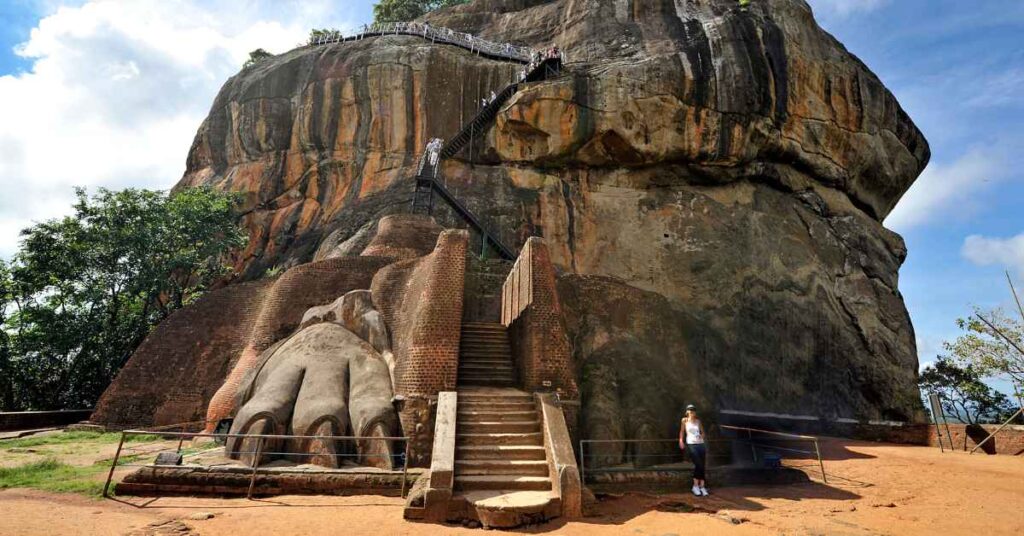
The ascent to the summit of Sigiriya, often considered a journey through time and terrain, is a captivating experience that offers not just physical exertion but a glimpse into the history and architectural brilliance of this ancient marvel.
The Terraced Gardens and Water Features
Embarking on the journey begins with traversing the terraced gardens—a meticulously crafted landscape that whispers tales of ancient horticultural expertise. Amidst the symmetrical pathways and water features, visitors can envision the once-lush greenery and vibrant blooms that adorned this surreal setting, showcasing the harmonious fusion of nature and human design.
Climbing the Steep Staircases
As travelers ascend further, the terrain transforms into a series of steep staircases and pathways carved into the rock. These ancient steps, worn by time and countless footsteps, bear witness to the passage of kings, monks, and pilgrims who sought the summit for different reasons across the centuries.
The Iconic Lion Gate
The pinnacle of the ascent is marked by the legendary Lion Gate, an imposing entrance guarded by colossal lion paws that once formed a majestic lion’s head. Despite the erosion that has weathered its features, the remnants of this formidable gate exude an aura of ancient grandeur, serving as a threshold to the summit fortress.
Panoramic Views from the Summit
Upon reaching the summit, a breathtaking panorama unfolds, rewarding the perseverance of the climbers. The vantage point offers sweeping views of the surrounding lush landscapes and distant horizons—a spectacle that speaks volumes about the strategic advantage Sigiriya provided to its ancient inhabitants.
Experience and Reflection
Ascending Sigiriya isn’t merely a physical journey; it’s an immersive experience that resonates with history and cultural significance. Each step echoes with the footsteps of ancient civilizations, inviting visitors to reflect on the perseverance and ingenuity of those who once inhabited this magnificent rock fortress.
Ascending the Lion’s Rock is a pilgrimage through time, offering a profound connection to the past and an appreciation for the architectural and natural splendor that defines Sigiriya. It’s a trek that not only challenges the body but also enriches the soul with the stories and wonders of a bygone era.
Cultural and Artistic Significance
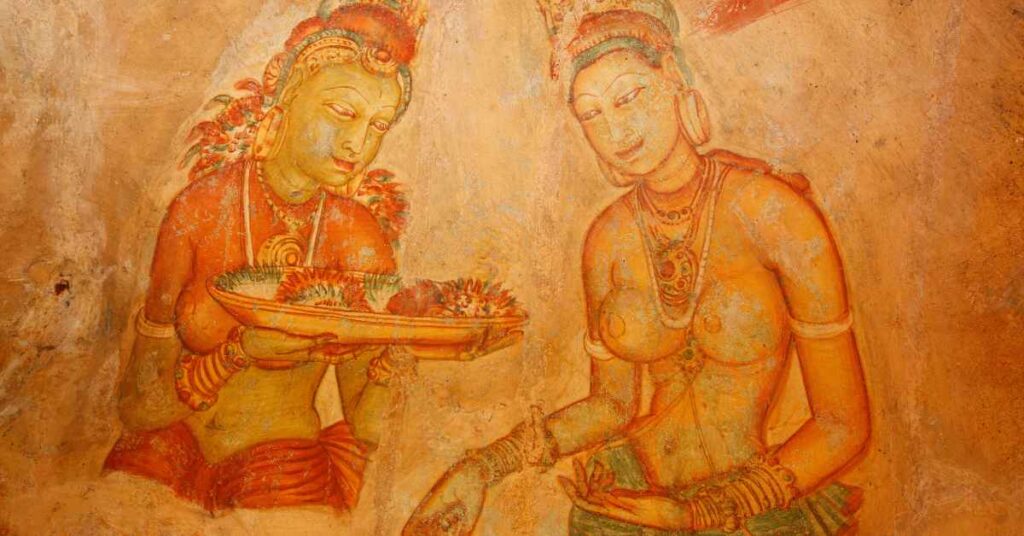
Sigiriya’s cultural and artistic significance transcends its structural grandeur, weaving tales of ancient lifestyles, artistic finesse, and societal norms prevalent during its era. From vibrant frescoes to the inscriptions on the Mirror Wall, each facet of Sigiriya offers a window into the cultural tapestry of ancient Sri Lanka.
Frescoes of Sigiriya
The frescoes adorning the sheltered rock face of Sigiriya depict the famed “Sigiriya Damsels,” a collection of female figures with enigmatic smiles and intricate attire. These paintings, though fragmented over time, remain a testament to the artistic mastery of ancient Sri Lankan painters. The detail and grace with which these figures are depicted not only showcase the aesthetic sensibilities of the era but also provide insights into the roles and status of women in ancient society.
The Mirror Wall Inscriptions
Etched along the Mirror Wall are inscriptions, poems, and musings left behind by visitors across centuries. Originally polished to a reflective sheen, this wall served not only as a protective barricade but also as a canvas for expressions of admiration and awe for Sigiriya’s beauty. These inscriptions offer glimpses into the emotions and experiences of those who traversed this ancient site, providing a human connection to the past and a collective appreciation for the rock fortress.
Interpretation and Cultural Legacy
Interpreting the frescoes and deciphering the inscriptions presents a fascinating challenge, inviting historians and enthusiasts to unravel the cultural nuances and societal aspects embedded within them. The depiction of clothing, hairstyles, and adornments in the frescoes, as well as the poetic expressions on the Mirror Wall, contribute to a deeper understanding of the values, traditions, and aesthetics prevalent in ancient Sri Lanka.
Influence on Sri Lankan Art and Culture
Sigiriya’s artistic motifs and cultural symbols have transcended time, influencing subsequent art forms and cultural expressions in Sri Lanka. Its impact extends beyond its historical significance, shaping the artistic landscape and serving as a source of inspiration for contemporary artists, writers, and cultural enthusiasts.
Sigiriya, with its rich artistic depictions and cultural remnants, serves as a repository of ancient heritage, inviting exploration and interpretation into the intricacies of a bygone era. Its frescoes and inscriptions remain a captivating testament to the artistic prowess and cultural nuances of ancient Sri Lanka.
Preservation Efforts and Challenges
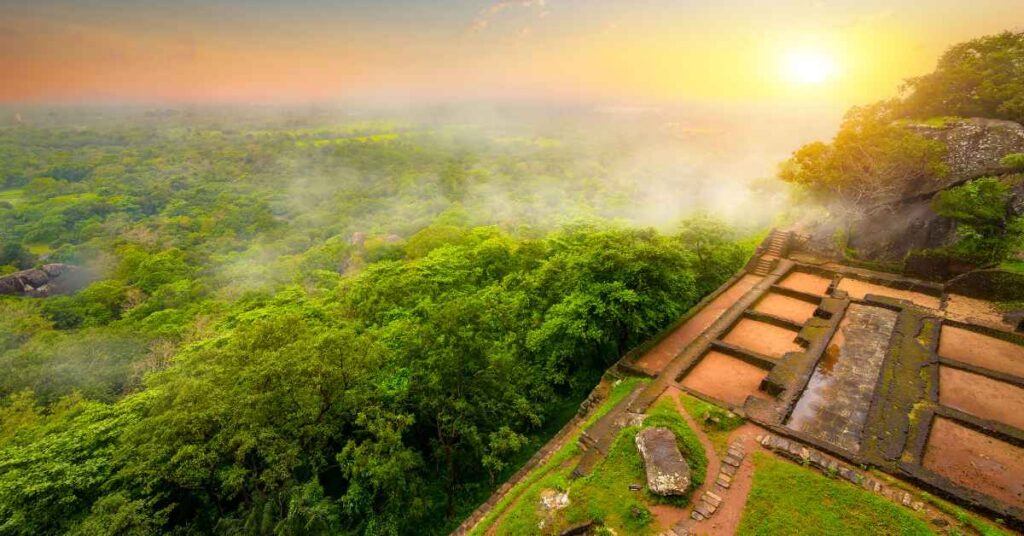
Preserving Sigiriya, a heritage site of immense historical and cultural significance, presents a dual challenge: safeguarding its architectural marvels for future generations while balancing the influx of visitors and environmental factors that threaten its integrity.
Conservation Initiatives
Numerous conservation efforts have been undertaken to protect Sigiriya’s ancient treasures. Collaborative endeavors between archaeological departments, conservationists, and UNESCO have focused on structural stability, restoration of frescoes, and the preservation of inscriptions. Advanced techniques in conservation, such as controlled environment monitoring and non-invasive restoration methods, have been employed to mitigate the effects of weathering and human impact.
Challenges in Preservation
The influx of tourists, while essential for promoting awareness and appreciation, poses a significant challenge to conservation efforts. Footfall on fragile structures, erosion from human touch, and the accumulation of environmental pollutants threaten the delicate balance of preservation. Moreover, natural elements like rain, wind, and vegetation growth continually test the resilience of Sigiriya’s ancient architecture.
Sustainable Tourism and Management
Efforts have been made to implement sustainable tourism practices to mitigate the impact of visitors on Sigiriya. Visitor management strategies, including regulated entry, guided tours, and designated pathways, aim to minimize direct contact with delicate structures. Educational initiatives and awareness campaigns emphasize the importance of responsible tourism, encouraging visitors to respect the site’s cultural significance and adhere to preservation guidelines.
Balancing Accessibility and Conservation
Balancing accessibility for tourists while preserving the site’s integrity remains a key challenge. Ensuring that visitors can experience Sigiriya’s historical and cultural richness without compromising its delicate features requires a delicate balance. Ongoing discussions and studies focus on finding innovative ways to enhance visitor experiences while minimizing their impact on the site’s preservation.
Future Sustainability
The future of Sigiriya’s preservation hinges on a collaborative approach between conservationists, government bodies, local communities, and visitors. Striking a harmonious balance between conservation, tourism, and cultural significance will be pivotal in safeguarding this iconic site for generations to come.
Preserving Sigiriya demands a delicate dance between conservation efforts and the challenges posed by human interaction and environmental factors. The ongoing commitment to responsible stewardship aims to ensure that this historical gem endures as a symbol of Sri Lanka’s rich heritage.
Tips for Visitors
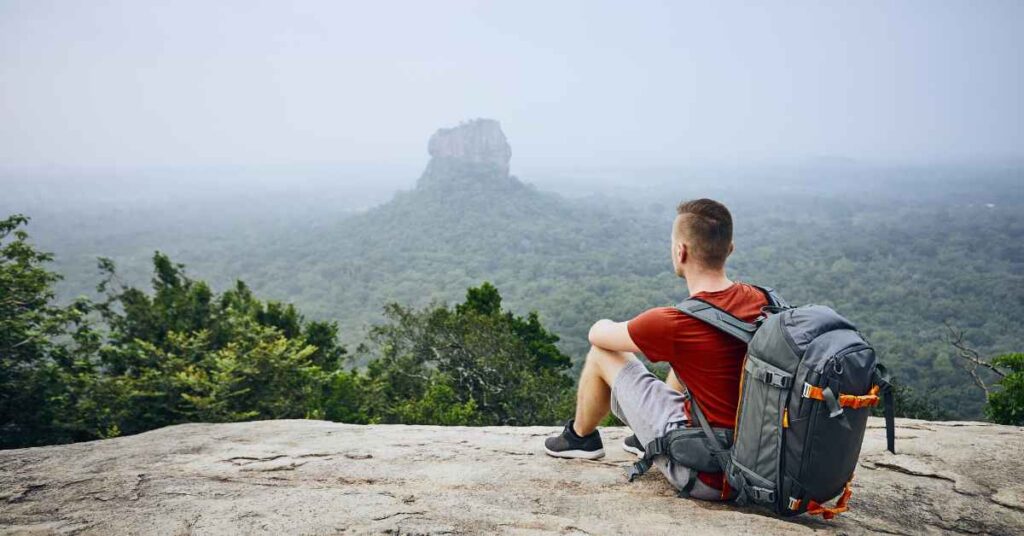
Visiting Sigiriya, the majestic Lion’s Rock, is a journey through ancient history and architectural brilliance. To make the most of this experience while respecting its cultural significance and preserving its heritage, here are some essential tips for visitors:
Planning Ahead
Before visiting Sigiriya, consider the best time to explore the site. Mornings or late afternoons are ideal to avoid the midday heat and crowds. Additionally, purchasing tickets in advance can save time and ensure a smoother entry.
Dress Code and Comfortable Attire
Respect the cultural norms by wearing appropriate clothing. As Sigiriya holds religious and historical significance, attire covering shoulders and knees is advisable. Comfortable footwear, preferably hiking or walking shoes, is essential due to the ascent and uneven terrain.
Hydration and Essentials
Carry sufficient water to stay hydrated throughout the climb. Sunscreen, hats, and sunglasses are crucial for protection against the sun’s rays, especially during the ascent to the summit. A small backpack to carry essentials is recommended.
Guided Tours and Information
Consider joining a guided tour or hiring a local guide at the entrance. Knowledgeable guides provide insights into Sigiriya’s history, architectural marvels, and cultural significance, enhancing the overall experience with their expertise and anecdotes.
Respect for the Site
While exploring Sigiriya, maintain respect for the ancient structures and cultural remnants. Refrain from touching frescoes, inscriptions, or any fragile elements. Avoid littering and follow designated pathways to minimize impact on the site’s preservation.
Pace Yourself and Enjoy the Views
The ascent to the summit can be demanding, so pace yourself and take breaks as needed. Embrace the opportunity to enjoy panoramic views at different points of the climb. The breathtaking vistas from the top make the effort worthwhile.
Photography and Memories
Capture the beauty of Sigiriya through photography but do so respectfully. Avoid using flash photography near frescoes to preserve their colors. Take time to absorb the surroundings and create lasting memories of this ancient wonder.
Following these tips not only enhances your visit to Sigiriya but also contributes to the preservation of its cultural heritage. Embrace the experience, immerse yourself in history, and leave with cherished memories of this iconic site.
Conclusion
Sigiriya, the iconic Lion’s Rock, stands as a testament to the ingenuity, artistry, and cultural richness of ancient Sri Lanka. Its towering presence amidst lush landscapes has captivated visitors for centuries, inviting them to unravel the enigmatic tales and architectural marvels woven into its very stone.
Enduring Legacy
Sigiriya’s enduring legacy lies not only in its physical structures but in the stories it holds. The tale of King Kasyapa’s ambition, the artistic finesse of the frescoes, and the ancient inscriptions etched on the Mirror Wall serve as windows to a bygone era—a time when this rock fortress stood as a symbol of power and artistic expression.
Preservation and Future
Preserving Sigiriya presents a continuous challenge, balancing conservation efforts with the influx of visitors and environmental factors. Sustainable tourism practices, conservation initiatives, and collaborative efforts hold the key to safeguarding this UNESCO World Heritage Site for future generations.
Invitation to Explore
Sigiriya stands not just as a historical relic but as an invitation to explore, learn, and appreciate the marvels of human creativity and endurance. Its panoramic views, architectural wonders, and cultural significance beckon travelers, historians, and enthusiasts to embark on a journey through time and terrain.
Symbol of Sri Lanka’s Heritage
As a symbol of Sri Lanka’s rich heritage and a treasure trove of ancient wonders, Sigiriya continues to inspire awe and reverence. Its presence on the UNESCO World Heritage list stands as a testament to its universal significance and the need to protect and cherish such cultural gems.
Sigiriya remains a timeless testament to the greatness of human achievement and artistic expression. It transcends generations, inviting all who visit to immerse themselves in its beauty, history, and cultural grandeur—a legacy that will endure for generations to come.
Read : Unveiling the Magnificence of Lotus Tower: Colombo’s Iconic Landmark in Sri Lanka

